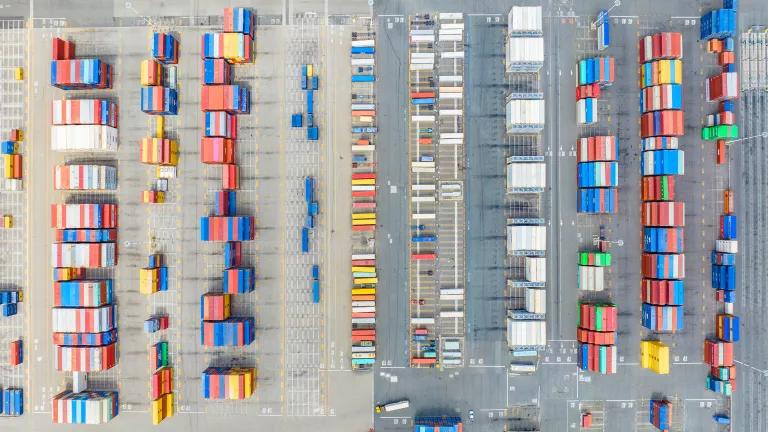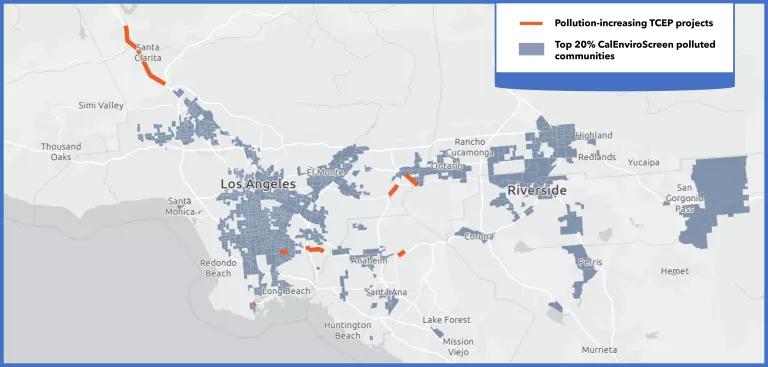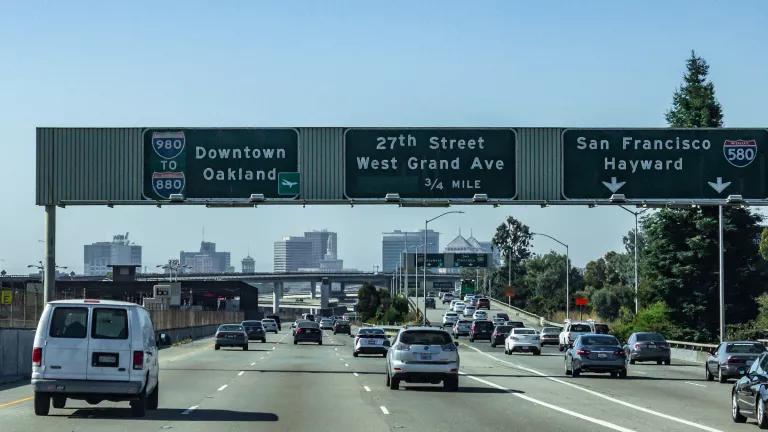Investing in Clean Air for California
California leaders can transform the state's most-polluting transportation program into climate, freight, and community benefits by supporting AB 2535 (Bonta)

Port of Oakland, CA
Thomas Hawk via Flickr, CC BY-NC 2.0 DEED
California’s lead agency for clean air and climate action, the California Air Resources Board (CARB), made clear in its newest greenhouse gas analysis for the state: the transportation sector remains the biggest source of climate pollution in California. As a critical step to curb this pollution, the Charge Ahead California campaign (led by Coalition for Clean Air, Communities for a Better Environment, Environment California, Greenlining Institute, and NRDC) is sponsoring Assembly Bill 2535 (Bonta). AB 2535 would reform the state’s most-polluting transportation infrastructure program, transforming it from an asphalt industry handout into benefits for climate, goods movement, and communities by investing in clean air—with targeted benefits in environmental justice communities.
To deliver on California’s promises for clean air and climate action, state leaders will need to reform the specific spending programs that have stubbornly resisted change. While the state has made important progress in shifting investments in several key funding programs, a short list of remaining programs remain resistant to change—chief among them, the Trade Corridor Enhancement Program (TCEP).
The legislature’s stated goals for TCEP in existing California law include both fostering more efficient goods movement and reducing pollution, especially in disadvantaged communities. Yet TCEP-funded projects have too-often failed to achieve either of these goals, while causing further harm to disadvantaged communities in the form of more traffic, more smog, and the asthma that comes with it (here’s a map overlaying TCEP-funded traffic-increasing projects with the state’s most pollution-burdened communities).
Nowhere is this pattern more evident than in Los Angeles County, where traffic congestion and its associated pollution and health burdens are ubiquitous. With TCEP-funded projects underway that include 41.9 new highway lane miles, every LA County driver can expect to spend an additional hour in traffic per year as a direct result of TCEP investments in the County. In addition to suffering the health and travel time consequences of these investments, LA County residents also contribute their state and federal gas tax dollars into TCEP’s budget, which has allocated $727 million for these pollution-increasing projects in the county over the past six years. Further adding to the unacceptable cost of the status quo, the additional traffic caused by TCEP projects will cost county residents $41 million in added fuel costs each year—providing a generous, taxpayer-funded subsidy to the oil and gas industry.

Several traffic- and pollution-increasing projects funded by TCEP in Southern California from 2018-2021 have exacerbated environmental injustice along highways running through the state’s most pollution-burdened communities.
Map by Ali Lehman, NRDC. Project data provided by Caltrans and the California Transportation Commission.
Major pollution challenges, with major economic and public health opportunities
On-road transportation—cars, large freight trucks, and everything in-between—comprise more than a third of California’s 2021 climate pollution, the most recent year for which data are available. CARB has also said that in addition to California’s internationally-leading zero-emission vehicle regulations, the state must take action to grow investments in projects that reduce congestion, clean the air, and foster safer and healthier communities—investments in sidewalks, safe bike infrastructure, zero-emissions vehicle charging infrastructure, and robust bus and train service.

The transportation sector remains the largest source of climate pollution in California, with on-road transportation producing approximately the same volume of greenhouse gas emissions as the power and industrial sectors combined.
California Air Resources Board, "California Greenhouse Gas Emissions from 2000-2021", 2023
Independent analysis of public data highlights the unacceptable public health costs of the transportation status quo—the American Lung Association gives 30 out of 49 California counties with available data an “F” grade for high ozone days, and 41 out of 46 counties an “F” for particle pollution in their 2023 State of the Air report card. California cities also occupy each of the top four worst rankings in both year-round particle pollution and ozone pollution.
Furthermore, a new tool published by RMI shows that by even partially achieving California’s ambitious goals (a 20 percent reduction in vehicle traffic by 2050, rather than CARB’s proposed target of 25 percent by 2030) would deliver life-saving public health, cost-saving, and climate benefits at a tremendous scale. These benefits include more than $400 billion in savings from avoided deaths and injuries in traffic crashes, more than $1 trillion total—or $60,000 per California household on average—in avoided transportation costs (including fuel, maintenance, and vehicle depreciation) for residents, $500 billion in economic benefit from avoided traffic congestion, and more than $2 trillion in public health benefits from lives saved in light of cleaner air and more physical activity. And all those benefits before considering the climate impact: nearly 200 million metric tons of avoided carbon emissions from now through 2050 – as if we planted a billion trees today, operated 1,600 wind turbines for the next 25 years, or prevented 16 fossil-gas-fueled power plants from ever being built.
Yet in spite of this multi-trillion dollar opportunity, California’s leaders have struggled to make progress on this central pillar of climate action in the transportation sector—shifting the state’s $20 billion in annual transportation infrastructure spending away from ineffective and fiscally-irresponsible highway projects and toward investments that would allow more Californians to make cleaner, healthier mobility choices. Powerful industry groups who benefit from the way things worked for most of the 20th century have fought to preserve their profits at the expense of the air we all breathe, even well into the 21st—but it’s time to prioritize clean air and community priorities over an outdated, polluting, and inequitable status quo.
A Well-Intentioned Program, Out of Balance (For Now)
The Trade Corridor Enhancement Program (TCEP) provides an instructive case study. Among this program’s statutory goals are improving the efficiency of the state’s goods-movement network and reducing pollution and “…other negative community impacts, especially in disadvantaged communities”. TCEP began awarding competitive funds in 2018—40 percent to the California Department of Transportation (Caltrans), and 60 percent to counties and other funding applicants—and approved its most recent investments in 2023, cumulatively providing more than $3.5 billion over six years. And for the first time, the list of projects funded by TCEP includes zero-emissions vehicle charging infrastructure—a major need for increased investment in California, which is leading the nation’s transition to zero-emissions vehicles due to both its Advanced Clean Trucks and Advanced Clean Fleets rules. With these landmark policies in place, investment in the required charging infrastructure is the next critical implementation step.
While freight efficiency is a critical goal given the state’s several major ports, TCEP’s role in causing adverse environmental and health impacts demands scrutiny. Of 103 TCEP projects funded to date, more than half (56 percent) of those projects, garnering more than $2.4 billion in funding over the past six years, are projected to add congestion to California’s already-traffic-choked roads, typically without providing freight trucks a way out of that that congestion. As a result, trucks will remain stuck in the same traffic they’ve always been in, and goods movement will be no more efficient.
To make matters worse, by using RMI’s SHIFT calculator, we can estimate that these projects’ cumulative 527 new miles of highway lanes will generate between two and three billion ‘vehicle miles traveled’ on California roads. This amount of new traffic would have pollution impacts similar to adding 16,000 new fossil fuel-powered vehicles to the road, in addition to adding even more traffic congestion to slow down everyone’s commutes.
By contrast, only 10 percent of the 103 TCEP-funded projects to date are likely to deliver sustained pollution reductions, for example by investing in new zero-emission freight infrastructure—underscoring the need for a more balanced approach to TCEP investments. It is possible to achieve this balance by advancing each of these goals simultaneously: prioritizing clean transportation options, improving the efficiency of the goods movement system, and reducing pollution throughout California—especially in the communities facing the highest pollution burdens today.
Targeted, commonsense reforms light a path forward
Bringing these goals into alignment would require a few targeted and commonsense reforms to TCEP:
- First, TCEP funding should no longer be used for projects that add “general purpose” lanes to the highway system. These investments fail on their face to achieve the program’s chief intended purpose—moving goods more efficiently—and add traffic and pollution to roads and communities alike. Instead, truck-only lanes or toll lanes that give trucks privileged access can succeed at moving trucks and the goods they carry out of traffic, which can in turn reduce air pollution that causes asthma and other respiratory disease.
- Second, in order to do no harm in disadvantaged communities, TCEP funding should no longer be used to fund new highway capacity of any kind in our most pollution-burdened communities.
- Finally, roughly the same share of TCEP spending that has historically led to increased traffic and pollution should be reprioritized for projects that instead eliminate pollution from the goods movement system—by allocating 50 percent of TCEP funds to pay for zero-emission vehicle infrastructure to power clean trucks, or to convert diesel-powered freight train fleets to electric, for example.
Assembly Bill 2535 (Bonta) proposes these much-needed and commonsense changes—now it’s up to state leaders to make these critical investments in clean air, efficient goods movement, climate action, and environmental justice.


.jpg.jpg?h=e309ec10&itok=YMNLEbG7)
